-

 40cm x 24cm A very popular Pipe Tobacco from the P.Carrolls Tobacco Company in Dundalk Co Louth was Mick McQuaids.But who was this legendary, smiling character the product was inspired by ??? The tales of Mick McQuaid were first written by William Francis Lynam – a soldier, writer and editor who was born in Galway in 1833 and died in Dublin in 1894. Little is known about his background (or his military career), but by the 1860s he was living in Dublin and was – it appears – the owner and editor of the Shamrock story paper. One of the earliest Irish story papers, it was established in 1866 as a penny weekly ‘companion’ paper to the Irishman newspaper. The Irishman, a very advanced nationalist paper, was established in 1859 by Richard Pigott – a very colourful character in Irish journalism who would acquire infamy as the forger of the damning letters supposedly written by Parnell in the 1880s. The exact editorial and proprietorial relationship between the Irishman and the Shamrock is rather murky – some sources imply Pigott owned them both, while others insist that Lynam owned the Shamrock, in which case the precise nature of their connection is unknown. Pigott and Lynam may have been actual business partners, or simply had an informal alliance. The 1860s was of course the era of the Fenian movement in Ireland and abroad, and under Pigott’s editorship the Irishmanwas a very popular voice for Fenianism. If the Irishman was aimed at an adult readership seeking radical political news and commentary, the Shamrock was its more entertaining younger sibling, intended to instil a sense of national pride and identity in its boy (and occasional girl) readers. To do this, it specialised in exciting Irish historical fiction serials, set at key moments of Irish nationalist history such as the 1798 Rebellion or the Jacobite Wars, and usually centred around an ordinary Irish boy who readers could identify with as he became swept into political and military excitements and encountered historical figures such as Wolfe Tone or Redmond O’Hanlon. But as well as historical fiction, the Shamrock also published romances and vernacular tales of Irish life. The most successful of these vernacular tales were, by a very long way, the Mick McQuaid stories. A series of comic tales (although to be quite honest the modern reader might take some convincing of that description) set in what was then contemporary Ireland, they all featured the adventures of central character Mick McQuaid – a quick-thinking, wise-cracking chancer who nevertheless usually managed to save the day and prevent the more straight-forward villainy of figures such as agents for absentee landlords, or local gombeen men. Each story saw Mick in a new role and setting, such as ‘Mick McQuaid, Money Lender’, ‘Mick McQuaid, Member of Parliament’, ‘Mick McQuaid, Detective’, and ‘Mick McQuaid, Evangelist’. Each story was long, with (overly) complex plots, many characters, comic tangents and multiple narrative threads to be resolved, so they were serialised in short instalments over several months of weekly issues. These kind of serial stories were crucial to story papers, designed to bring readers back week after week and build a loyal and regular readership, and the Mick McQuaid stories were a classic example of their type. It has to be admitted it would be difficult to that claim the stories deserve to be ‘rediscovered’ by modern readers. They are an interesting window into popular fiction of the era, especially in terms of their representations of Irish life and society – however their plots are unwieldy, their humour has not aged well and they are written in an almost impenetrable ‘Irish’ dialect which was obviously part of their appeal in the 1860s but which is extremely difficult to read now. Instead what is most interesting about the Mick McQuaid stories is their extraordinary popularity across many decades. Lynam reportedly became bored with the stories after just a few years, and indeed replaced them with tales of another very similar ‘charming Irish rogue’ anti-hero, the Darby Durkan series, which in their turn were also fairly popular. But popular demand for continued Mick McQuaid stories forced him to write more of them (a common experience for authors of popular fiction, most famously in the case of Conan Doyle’s reluctant resurrection of Sherlock Holmes). Indeed, the circulation of the Shamrock reportedly dropped sharply when he attempted to end the McQuaid stories, so they had to be revived and reprinted. It is difficult to be sure exactly how many stories there are in total (perhaps ten or so), each one lasting up to 6 months of weekly instalments – but for a youthful audience this was enough to keep printing and reprinting them over years and eventually decades. Rather like the endlessly circulating repeats of television sit-coms in our own era, which happily rewatched by fans and watched for the first time by successive generations (Faulty Towers being the obvious example, with just twelve episodes ever made in the 1970s, but which are still being screened 40 years later) these very popular serials played on an endless loop in the story papers. Lynam died in 1894, but his serials lived on without him. The Darby Durkan stories appeared in the Shamrock’s rival story paper the Emerald in the early 20thC, and after the two papers merged in 1912 the McQuaid stories also continued in the new paper until its demise in 1919 – and may well have continued to appear in other publications after that although I have yet to find them. Their popularity was such that in 1889 Carroll’s Tobacco company in Dundalk named a new brand of pipe tobacco after Mick McQuaid, who often smoked a pipe in the stories as he held forth with his distinctive folk wisdom. The brand was itself a great success (presumably the tobacco and the stories amplified each other’s standing among readers and smokers in ways that benefitted both), and by the 1920s Carroll’s had commissioned a cartoon version of Mick McQuaid for their packaging and advertising – the photograph accompanying this post is of a tobacco tin from the mid-20thC. So while the stories had not had significant illustrations during their 19thC hey-day, the Mick McQuaid character took visual form years after his author’s death, and in fact became one of mid-20thC Ireland’s most successful brands, only being discontinued in 2016 – a strange afterlife for a fictional character first invented in 1867.
40cm x 24cm A very popular Pipe Tobacco from the P.Carrolls Tobacco Company in Dundalk Co Louth was Mick McQuaids.But who was this legendary, smiling character the product was inspired by ??? The tales of Mick McQuaid were first written by William Francis Lynam – a soldier, writer and editor who was born in Galway in 1833 and died in Dublin in 1894. Little is known about his background (or his military career), but by the 1860s he was living in Dublin and was – it appears – the owner and editor of the Shamrock story paper. One of the earliest Irish story papers, it was established in 1866 as a penny weekly ‘companion’ paper to the Irishman newspaper. The Irishman, a very advanced nationalist paper, was established in 1859 by Richard Pigott – a very colourful character in Irish journalism who would acquire infamy as the forger of the damning letters supposedly written by Parnell in the 1880s. The exact editorial and proprietorial relationship between the Irishman and the Shamrock is rather murky – some sources imply Pigott owned them both, while others insist that Lynam owned the Shamrock, in which case the precise nature of their connection is unknown. Pigott and Lynam may have been actual business partners, or simply had an informal alliance. The 1860s was of course the era of the Fenian movement in Ireland and abroad, and under Pigott’s editorship the Irishmanwas a very popular voice for Fenianism. If the Irishman was aimed at an adult readership seeking radical political news and commentary, the Shamrock was its more entertaining younger sibling, intended to instil a sense of national pride and identity in its boy (and occasional girl) readers. To do this, it specialised in exciting Irish historical fiction serials, set at key moments of Irish nationalist history such as the 1798 Rebellion or the Jacobite Wars, and usually centred around an ordinary Irish boy who readers could identify with as he became swept into political and military excitements and encountered historical figures such as Wolfe Tone or Redmond O’Hanlon. But as well as historical fiction, the Shamrock also published romances and vernacular tales of Irish life. The most successful of these vernacular tales were, by a very long way, the Mick McQuaid stories. A series of comic tales (although to be quite honest the modern reader might take some convincing of that description) set in what was then contemporary Ireland, they all featured the adventures of central character Mick McQuaid – a quick-thinking, wise-cracking chancer who nevertheless usually managed to save the day and prevent the more straight-forward villainy of figures such as agents for absentee landlords, or local gombeen men. Each story saw Mick in a new role and setting, such as ‘Mick McQuaid, Money Lender’, ‘Mick McQuaid, Member of Parliament’, ‘Mick McQuaid, Detective’, and ‘Mick McQuaid, Evangelist’. Each story was long, with (overly) complex plots, many characters, comic tangents and multiple narrative threads to be resolved, so they were serialised in short instalments over several months of weekly issues. These kind of serial stories were crucial to story papers, designed to bring readers back week after week and build a loyal and regular readership, and the Mick McQuaid stories were a classic example of their type. It has to be admitted it would be difficult to that claim the stories deserve to be ‘rediscovered’ by modern readers. They are an interesting window into popular fiction of the era, especially in terms of their representations of Irish life and society – however their plots are unwieldy, their humour has not aged well and they are written in an almost impenetrable ‘Irish’ dialect which was obviously part of their appeal in the 1860s but which is extremely difficult to read now. Instead what is most interesting about the Mick McQuaid stories is their extraordinary popularity across many decades. Lynam reportedly became bored with the stories after just a few years, and indeed replaced them with tales of another very similar ‘charming Irish rogue’ anti-hero, the Darby Durkan series, which in their turn were also fairly popular. But popular demand for continued Mick McQuaid stories forced him to write more of them (a common experience for authors of popular fiction, most famously in the case of Conan Doyle’s reluctant resurrection of Sherlock Holmes). Indeed, the circulation of the Shamrock reportedly dropped sharply when he attempted to end the McQuaid stories, so they had to be revived and reprinted. It is difficult to be sure exactly how many stories there are in total (perhaps ten or so), each one lasting up to 6 months of weekly instalments – but for a youthful audience this was enough to keep printing and reprinting them over years and eventually decades. Rather like the endlessly circulating repeats of television sit-coms in our own era, which happily rewatched by fans and watched for the first time by successive generations (Faulty Towers being the obvious example, with just twelve episodes ever made in the 1970s, but which are still being screened 40 years later) these very popular serials played on an endless loop in the story papers. Lynam died in 1894, but his serials lived on without him. The Darby Durkan stories appeared in the Shamrock’s rival story paper the Emerald in the early 20thC, and after the two papers merged in 1912 the McQuaid stories also continued in the new paper until its demise in 1919 – and may well have continued to appear in other publications after that although I have yet to find them. Their popularity was such that in 1889 Carroll’s Tobacco company in Dundalk named a new brand of pipe tobacco after Mick McQuaid, who often smoked a pipe in the stories as he held forth with his distinctive folk wisdom. The brand was itself a great success (presumably the tobacco and the stories amplified each other’s standing among readers and smokers in ways that benefitted both), and by the 1920s Carroll’s had commissioned a cartoon version of Mick McQuaid for their packaging and advertising – the photograph accompanying this post is of a tobacco tin from the mid-20thC. So while the stories had not had significant illustrations during their 19thC hey-day, the Mick McQuaid character took visual form years after his author’s death, and in fact became one of mid-20thC Ireland’s most successful brands, only being discontinued in 2016 – a strange afterlife for a fictional character first invented in 1867. -
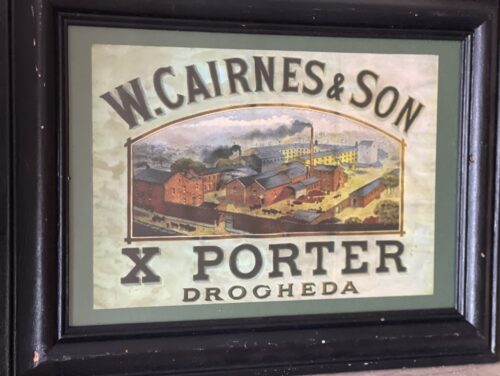
 38cm x 30cm Drogheda W.Cairnes & Son Ltd, Drogheda, Co Louth, Ireland. Founded 1828 by William Cairnes. Registered April 1890 as the Castlebellingham & Drogheda Breweries Ltd. to acquire John Woolsey & Co. Ltd, Castlebellingham and William Cairnes & Son. Name changed as above in November 1933. Acquired by Guinness and ceased brewing in October 1959. From the Brewery History Society Journal Number 91 Founded in 1828 by William Cairnes with good markets in both Dublin and Belfast. In 1850 they extended their malt liquor portfolio to include porter. The brewery was closed in 1959 as part of a rationalisation plan when the Cherry-Cairnes partnership was dissolved, to be subsequently replaced by the Irish Ale Breweries Group, (a Guinness/Allied Breweries combination). Irish Ale Breweries was formally dissolved in 1988, becoming Guinness Ireland.
38cm x 30cm Drogheda W.Cairnes & Son Ltd, Drogheda, Co Louth, Ireland. Founded 1828 by William Cairnes. Registered April 1890 as the Castlebellingham & Drogheda Breweries Ltd. to acquire John Woolsey & Co. Ltd, Castlebellingham and William Cairnes & Son. Name changed as above in November 1933. Acquired by Guinness and ceased brewing in October 1959. From the Brewery History Society Journal Number 91 Founded in 1828 by William Cairnes with good markets in both Dublin and Belfast. In 1850 they extended their malt liquor portfolio to include porter. The brewery was closed in 1959 as part of a rationalisation plan when the Cherry-Cairnes partnership was dissolved, to be subsequently replaced by the Irish Ale Breweries Group, (a Guinness/Allied Breweries combination). Irish Ale Breweries was formally dissolved in 1988, becoming Guinness Ireland. -
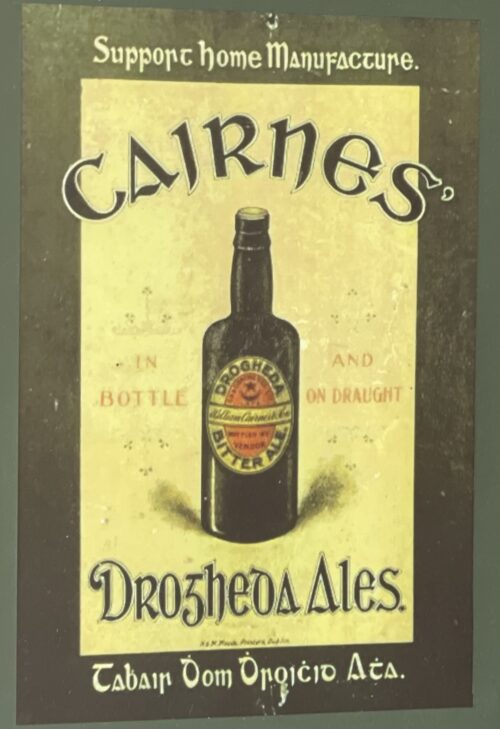
 38cm x 30cm Drogheda Cairnes Ltd, Drogheda, Co Louth, Ireland. Founded 1828 by William Cairnes. Registered April 1890 as the Castlebellingham & Drogheda Breweries Ltd. to acquire John Woolsey & Co. Ltd, Castlebellingham and William Cairnes & Son. Name changed as above in November 1933. Acquired by Guinness and ceased brewing in October 1959. From the Brewery History Society Journal Number 91 Founded in 1828 by William Cairnes with good markets in both Dublin and Belfast. In 1850 they extended their malt liquor portfolio to include porter. The brewery was closed in 1959 as part of a rationalisation plan when the Cherry-Cairnes partnership was dissolved, to be subsequently replaced by the Irish Ale Breweries Group, (a Guinness/Allied Breweries combination). Irish Ale Breweries was formally dissolved in 1988, becoming Guinness Ireland.
38cm x 30cm Drogheda Cairnes Ltd, Drogheda, Co Louth, Ireland. Founded 1828 by William Cairnes. Registered April 1890 as the Castlebellingham & Drogheda Breweries Ltd. to acquire John Woolsey & Co. Ltd, Castlebellingham and William Cairnes & Son. Name changed as above in November 1933. Acquired by Guinness and ceased brewing in October 1959. From the Brewery History Society Journal Number 91 Founded in 1828 by William Cairnes with good markets in both Dublin and Belfast. In 1850 they extended their malt liquor portfolio to include porter. The brewery was closed in 1959 as part of a rationalisation plan when the Cherry-Cairnes partnership was dissolved, to be subsequently replaced by the Irish Ale Breweries Group, (a Guinness/Allied Breweries combination). Irish Ale Breweries was formally dissolved in 1988, becoming Guinness Ireland. -
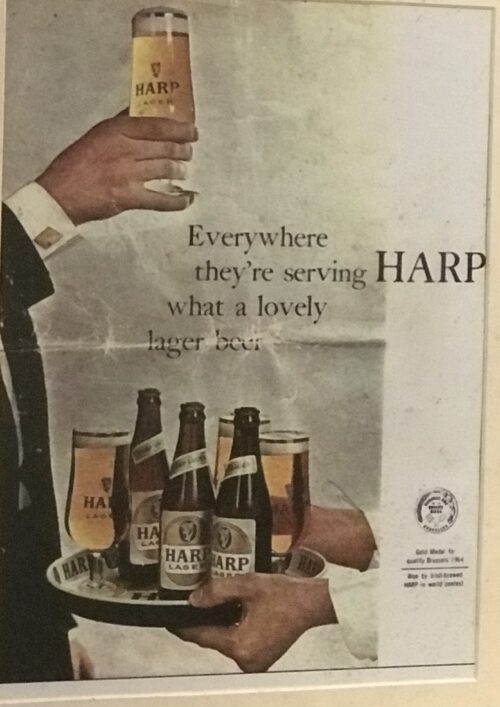
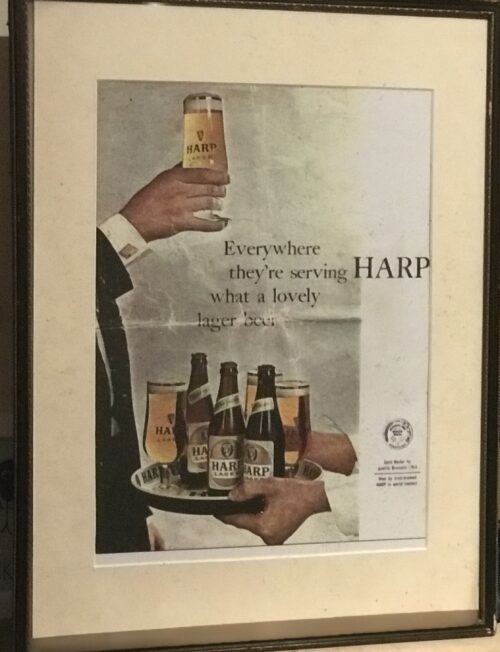 Classic 1960s Harp Lager advert. 55cm x 40cm Dublin Harp was first produced in 1960 as a bottled beer by the Guinness company (now Diageo), in response to the trend among drinkers in Britain and Ireland towards Continental lager. Guinness converted its Dundalk brewery into a modern lager production plant with the guidance of Dr. Herman Muender, a distinguished German brewer. Various names were considered for the brand, including Atlas, Cresta and Dolphin, before Harp was chosen.The brand was marketed with the Brian Boru harp as its emblem. By 1961 a consortium of brewers, Courage, Barclay & Simonds, Scottish & Newcastle, Bass, Mitchells & Butlers and Guinness, grouped together as Harp Lager Ltd to brew and market the beer.Courage's Alton Brewery, where Courage Director's had been brewed, was rebuilt to produce the lager in Great Britain. By 1964, the product was being sold on draught and led in its category for sales. Members of the Harp consortium changed over the years, with Courage and Scottish & Newcastle leaving in 1979, but becoming franchisees. Currently available on draught, and in 330ml and 500ml bottles, its top market is Ulster, especially Northern Ireland and County Donegal. In 2005, Harp saw a makeover as Diageo Ireland separated the brand from Guinness. On 9 May 2008, Diageo Ireland announced that it would close the Dundalk Brewery along with the Kilkenny Brewery over a five-year period. The last Harp was brewed at Great Northern in October 2013, after which production moved to Diageo's sole Irish brewery, St James's Gate Brewery in St. James's Gate, Dublin. Today, Harp is brewed in the Dublin brewery for Ireland and Hydes Brewery for Great Britain.In Australia, distribution is handled by Carlton & United Breweries. Harp sold in America is brewed in Canada by Guinness Canada and is typically brewed at the Moosehead Brewery in New Brunswick.
Classic 1960s Harp Lager advert. 55cm x 40cm Dublin Harp was first produced in 1960 as a bottled beer by the Guinness company (now Diageo), in response to the trend among drinkers in Britain and Ireland towards Continental lager. Guinness converted its Dundalk brewery into a modern lager production plant with the guidance of Dr. Herman Muender, a distinguished German brewer. Various names were considered for the brand, including Atlas, Cresta and Dolphin, before Harp was chosen.The brand was marketed with the Brian Boru harp as its emblem. By 1961 a consortium of brewers, Courage, Barclay & Simonds, Scottish & Newcastle, Bass, Mitchells & Butlers and Guinness, grouped together as Harp Lager Ltd to brew and market the beer.Courage's Alton Brewery, where Courage Director's had been brewed, was rebuilt to produce the lager in Great Britain. By 1964, the product was being sold on draught and led in its category for sales. Members of the Harp consortium changed over the years, with Courage and Scottish & Newcastle leaving in 1979, but becoming franchisees. Currently available on draught, and in 330ml and 500ml bottles, its top market is Ulster, especially Northern Ireland and County Donegal. In 2005, Harp saw a makeover as Diageo Ireland separated the brand from Guinness. On 9 May 2008, Diageo Ireland announced that it would close the Dundalk Brewery along with the Kilkenny Brewery over a five-year period. The last Harp was brewed at Great Northern in October 2013, after which production moved to Diageo's sole Irish brewery, St James's Gate Brewery in St. James's Gate, Dublin. Today, Harp is brewed in the Dublin brewery for Ireland and Hydes Brewery for Great Britain.In Australia, distribution is handled by Carlton & United Breweries. Harp sold in America is brewed in Canada by Guinness Canada and is typically brewed at the Moosehead Brewery in New Brunswick. An advertising hoarding in BelfastFor many years the slogan "Harp stays sharp" was used in advertisements. It was written by the advertising executive Rod Allen. Recently it has used the slogan "Look on the Harp side".Most famously Harp got a serious and immortal mention in the chorus of the Christy Moore classic song-Delirium Tremens!"Goodbye to the Port and Brandy, to the Vodka and the Stag, To the Schmiddick and the Harpic, the bottled draught and keg. As I sat lookin’ up the Guinness ad I could never figure out How your man stayed up on the surfboard after 14 pints of stout."
An advertising hoarding in BelfastFor many years the slogan "Harp stays sharp" was used in advertisements. It was written by the advertising executive Rod Allen. Recently it has used the slogan "Look on the Harp side".Most famously Harp got a serious and immortal mention in the chorus of the Christy Moore classic song-Delirium Tremens!"Goodbye to the Port and Brandy, to the Vodka and the Stag, To the Schmiddick and the Harpic, the bottled draught and keg. As I sat lookin’ up the Guinness ad I could never figure out How your man stayed up on the surfboard after 14 pints of stout." -
 Vintage John Jameson Whiskey advert featuring the ubiquitous Barrel Man. 27cm x 34cm Dunleer,Co Louth John Jameson was originally a lawyer from Alloa in Scotland before he founded his eponymous distillery in Dublin in 1780.Prevoius to this he had made the wise move of marrying Margaret Haig (1753–1815) in 1768,one of the simple reasons being Margaret was the eldest daughter of John Haig, the famous whisky distiller in Scotland. John and Margaret had eight sons and eight daughters, a family of 16 children. Portraits of the couple by Sir Henry Raeburn are on display in the National Gallery of Ireland. John Jameson joined the Convivial Lodge No. 202, of the Dublin Freemasons on the 24th June 1774 and in 1780, Irish whiskey distillation began at Bow Street. In 1805, he was joined by his son John Jameson II who took over the family business that year and for the next 41 years, John Jameson II built up the business before handing over to his son John Jameson the 3rd in 1851. In 1901, the Company was formally incorporated as John Jameson and Son Ltd. Four of John Jameson’s sons followed his footsteps in distilling in Ireland, John Jameson II (1773 – 1851) at Bow Street, William and James Jameson at Marrowbone Lane in Dublin (where they partnered their Stein relations, calling their business Jameson and Stein, before settling on William Jameson & Co.). The fourth of Jameson's sons, Andrew, who had a small distillery at Enniscorthy, Co. Wexford, was the grandfather of Guglielmo Marconi, inventor of wireless telegraphy. Marconi’s mother was Annie Jameson, Andrew’s daughter. John Jameson’s eldest son, Robert took over his father’s legal business in Alloa. The Jamesons became the most important distilling family in Ireland, despite rivalry between the Bow Street and Marrowbone Lane distilleries. By the turn of the 19th century, it was the second largest producer in Ireland and one of the largest in the world, producing 1,000,000 gallons annually. Dublin at the time was the centre of world whiskey production. It was the second most popular spirit in the world after rum and internationally Jameson had by 1805 become the world's number one whiskey. Today, Jameson is the world's third largest single-distillery whiskey. Historical events, for a time, set the company back. The temperance movement in Ireland had an enormous impact domestically but the two key events that affected Jameson were the Irish War of Independence and subsequent trade war with the British which denied Jameson the export markets of the Commonwealth, and shortly thereafter, the introduction of prohibition in the United States. While Scottish brands could easily slip across the Canada–US border, Jameson was excluded from its biggest market for many years. The introduction of column stills by the Scottish blenders in the mid-19th-century enabled increased production that the Irish, still making labour-intensive single pot still whiskey, could not compete with. There was a legal enquiry somewhere in 1908 to deal with the trade definition of whiskey. The Scottish producers won within some jurisdictions, and blends became recognised in the law of that jurisdiction as whiskey. The Irish in general, and Jameson in particular, continued with the traditional pot still production process for many years.In 1966 John Jameson merged with Cork Distillers and John Powers to form the Irish Distillers Group. In 1976, the Dublin whiskey distilleries of Jameson in Bow Street and in John's Lane were closed following the opening of a New Midleton Distillery by Irish Distillers outside Cork. The Midleton Distillery now produces much of the Irish whiskey sold in Ireland under the Jameson, Midleton, Powers, Redbreast, Spot and Paddy labels. The new facility adjoins the Old Midleton Distillery, the original home of the Paddy label, which is now home to the Jameson Experience Visitor Centre and the Irish Whiskey Academy. The Jameson brand was acquired by the French drinks conglomerate Pernod Ricard in 1988, when it bought Irish Distillers. The old Jameson Distillery in Bow Street near Smithfield in Dublin now serves as a museum which offers tours and tastings. The distillery, which is historical in nature and no longer produces whiskey on site, went through a $12.6 million renovation that was concluded in March 2016, and is now a focal part of Ireland's strategy to raise the number of whiskey tourists, which stood at 600,000 in 2017.Bow Street also now has a fully functioning Maturation Warehouse within its walls since the 2016 renovation. It is here that Jameson 18 Bow Street is finished before being bottled at Cask Strength. In 2008, The Local, an Irish pub in Minneapolis, sold 671 cases of Jameson (22 bottles a day),making it the largest server of Jameson's in the world – a title it maintained for four consecutive years.
Vintage John Jameson Whiskey advert featuring the ubiquitous Barrel Man. 27cm x 34cm Dunleer,Co Louth John Jameson was originally a lawyer from Alloa in Scotland before he founded his eponymous distillery in Dublin in 1780.Prevoius to this he had made the wise move of marrying Margaret Haig (1753–1815) in 1768,one of the simple reasons being Margaret was the eldest daughter of John Haig, the famous whisky distiller in Scotland. John and Margaret had eight sons and eight daughters, a family of 16 children. Portraits of the couple by Sir Henry Raeburn are on display in the National Gallery of Ireland. John Jameson joined the Convivial Lodge No. 202, of the Dublin Freemasons on the 24th June 1774 and in 1780, Irish whiskey distillation began at Bow Street. In 1805, he was joined by his son John Jameson II who took over the family business that year and for the next 41 years, John Jameson II built up the business before handing over to his son John Jameson the 3rd in 1851. In 1901, the Company was formally incorporated as John Jameson and Son Ltd. Four of John Jameson’s sons followed his footsteps in distilling in Ireland, John Jameson II (1773 – 1851) at Bow Street, William and James Jameson at Marrowbone Lane in Dublin (where they partnered their Stein relations, calling their business Jameson and Stein, before settling on William Jameson & Co.). The fourth of Jameson's sons, Andrew, who had a small distillery at Enniscorthy, Co. Wexford, was the grandfather of Guglielmo Marconi, inventor of wireless telegraphy. Marconi’s mother was Annie Jameson, Andrew’s daughter. John Jameson’s eldest son, Robert took over his father’s legal business in Alloa. The Jamesons became the most important distilling family in Ireland, despite rivalry between the Bow Street and Marrowbone Lane distilleries. By the turn of the 19th century, it was the second largest producer in Ireland and one of the largest in the world, producing 1,000,000 gallons annually. Dublin at the time was the centre of world whiskey production. It was the second most popular spirit in the world after rum and internationally Jameson had by 1805 become the world's number one whiskey. Today, Jameson is the world's third largest single-distillery whiskey. Historical events, for a time, set the company back. The temperance movement in Ireland had an enormous impact domestically but the two key events that affected Jameson were the Irish War of Independence and subsequent trade war with the British which denied Jameson the export markets of the Commonwealth, and shortly thereafter, the introduction of prohibition in the United States. While Scottish brands could easily slip across the Canada–US border, Jameson was excluded from its biggest market for many years. The introduction of column stills by the Scottish blenders in the mid-19th-century enabled increased production that the Irish, still making labour-intensive single pot still whiskey, could not compete with. There was a legal enquiry somewhere in 1908 to deal with the trade definition of whiskey. The Scottish producers won within some jurisdictions, and blends became recognised in the law of that jurisdiction as whiskey. The Irish in general, and Jameson in particular, continued with the traditional pot still production process for many years.In 1966 John Jameson merged with Cork Distillers and John Powers to form the Irish Distillers Group. In 1976, the Dublin whiskey distilleries of Jameson in Bow Street and in John's Lane were closed following the opening of a New Midleton Distillery by Irish Distillers outside Cork. The Midleton Distillery now produces much of the Irish whiskey sold in Ireland under the Jameson, Midleton, Powers, Redbreast, Spot and Paddy labels. The new facility adjoins the Old Midleton Distillery, the original home of the Paddy label, which is now home to the Jameson Experience Visitor Centre and the Irish Whiskey Academy. The Jameson brand was acquired by the French drinks conglomerate Pernod Ricard in 1988, when it bought Irish Distillers. The old Jameson Distillery in Bow Street near Smithfield in Dublin now serves as a museum which offers tours and tastings. The distillery, which is historical in nature and no longer produces whiskey on site, went through a $12.6 million renovation that was concluded in March 2016, and is now a focal part of Ireland's strategy to raise the number of whiskey tourists, which stood at 600,000 in 2017.Bow Street also now has a fully functioning Maturation Warehouse within its walls since the 2016 renovation. It is here that Jameson 18 Bow Street is finished before being bottled at Cask Strength. In 2008, The Local, an Irish pub in Minneapolis, sold 671 cases of Jameson (22 bottles a day),making it the largest server of Jameson's in the world – a title it maintained for four consecutive years. -
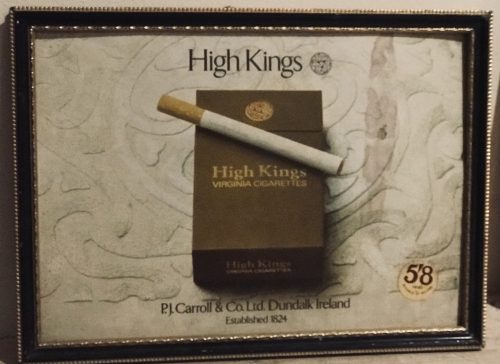 Cool framed showcard from P.J Carroll & Co.Ltd Dundalk Ireland Established 1824 High Kings Cigarettes Retro advert.Sticker with the then current price of a pack of 20- 5'8 (5 shillings and 8 pence) !! Origins : Tralee Co Kerry Dimensions : 20cm x 27cm GlazedP. J. Carroll & Company Limited, often called Carroll's, is a tobacco company in Republic of Ireland. It is Ireland's oldest tobacco manufacturer and is now a subsidiary of British American Tobacco Plc.Its cigarette brands were among the best selling in Ireland in the twentieth century. Its factory was for decades the largest employer in Dundalk. Patrick James Carroll (b. 1803) completed his apprenticeship as a tobacconist in 1824 and opened a shop in Dundalk, later also manufacturing cigars.Patrick James moved to Liverpool in the 1850s. His son Vincent Stannus Carroll expanded the firm in the later 19th century.His son James Marmion Carroll moved to a house outside Dundalk.A second factory was opened, in Liverpool, in 1923. The company went public in 1934. A purpose-built factory opened in 1970. Designed by Ronnie Tallon of Michael Scott and Partners, it was described by Frank McDonald as "way ahead of anything else in Ireland at the time". In 1974 to mark the 150th anniversary of its founding, P.J. Carroll published an illustrated booklet by the writer James Plunkett: P. J. Carroll & Co. Ltd, Dublin & Dundalk - A Retrospect, outlining the development of the company in its historical context. Carroll's was acquired by Rothmans in 1990; Rothmans was acquired by British American Tobacco Plc in 1998. The company's share of the Irish tobacco market is around 17%. In 2002 the Dundalk site was sold for €16.4m to the Department of Education and repurposed for the campus of Dundalk Institute of Technology. Carroll's rented back a small section for its remaining factory operations, until finally ceasing its Dundalk operations in 2008. Carrolls remains an Irish company with deep connections to hundreds of retirees and nearly 40 staff based in their Dublin offices
Cool framed showcard from P.J Carroll & Co.Ltd Dundalk Ireland Established 1824 High Kings Cigarettes Retro advert.Sticker with the then current price of a pack of 20- 5'8 (5 shillings and 8 pence) !! Origins : Tralee Co Kerry Dimensions : 20cm x 27cm GlazedP. J. Carroll & Company Limited, often called Carroll's, is a tobacco company in Republic of Ireland. It is Ireland's oldest tobacco manufacturer and is now a subsidiary of British American Tobacco Plc.Its cigarette brands were among the best selling in Ireland in the twentieth century. Its factory was for decades the largest employer in Dundalk. Patrick James Carroll (b. 1803) completed his apprenticeship as a tobacconist in 1824 and opened a shop in Dundalk, later also manufacturing cigars.Patrick James moved to Liverpool in the 1850s. His son Vincent Stannus Carroll expanded the firm in the later 19th century.His son James Marmion Carroll moved to a house outside Dundalk.A second factory was opened, in Liverpool, in 1923. The company went public in 1934. A purpose-built factory opened in 1970. Designed by Ronnie Tallon of Michael Scott and Partners, it was described by Frank McDonald as "way ahead of anything else in Ireland at the time". In 1974 to mark the 150th anniversary of its founding, P.J. Carroll published an illustrated booklet by the writer James Plunkett: P. J. Carroll & Co. Ltd, Dublin & Dundalk - A Retrospect, outlining the development of the company in its historical context. Carroll's was acquired by Rothmans in 1990; Rothmans was acquired by British American Tobacco Plc in 1998. The company's share of the Irish tobacco market is around 17%. In 2002 the Dundalk site was sold for €16.4m to the Department of Education and repurposed for the campus of Dundalk Institute of Technology. Carroll's rented back a small section for its remaining factory operations, until finally ceasing its Dundalk operations in 2008. Carrolls remains an Irish company with deep connections to hundreds of retirees and nearly 40 staff based in their Dublin officesBrands
- "Carrolls Number 1", its first filter cigarette, was launched in 1958.
- "Carrolls Additive Free* Red" and "Carrolls Additive Free* Blue" was launched in 2013 as additive free* cigarettes started to gain popularity across Western Europe.
- "Pall Mall" is one of PJ Carroll's strongest growing brands.
- Vogue is PJ Carroll's premium cigarette brand.
- "Major",[4] a full flavor cigarette.
- "Sweet Afton", launched in 1919, was named after "'Afton Waters" by Robert Burns, whose sister Agnes was buried in a graveyard opposite the old Carrolls factory in Church Street, Dundalk.[2]Sweet Afton cigarettes were discontinued in the Autumn of 2011.
Sponsorship
Carroll's was a major sponsor of sport in Ireland until restrictions were imposed on tobacco advertising. The company had naming rights over the GAA All Stars Awards (1971–78);and Irish showjumping horses of the 1970s and 80s, such as the great "Carroll's Boomerang" ridden by Eddie Macken. In golf, Carroll's was the sponsor of several professional tournaments including the Carroll's International (1963 to 1974), the Carroll's Number 1 Tournament (1965 to 1968), the Carroll's Irish Match Play Championship (1969 to 1982),[10] and most notably the revived Irish Open from 1975 to 1993. -
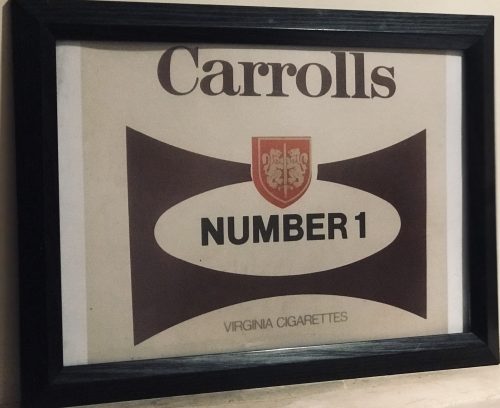 Carrolls Number 1 Virginia Cigarettes Retro advert fashioned from the blood, sweat,tears and spillage of a well used Irish Bar Trays & enamel signs.Using high quality reprographics we have brought every scratch,dent and mark back to life in the shape of this unique series of prints. Dimensions : 35cm x 48cm GlazedP. J. Carroll & Company Limited, often called Carroll's, is a tobacco company in Republic of Ireland. It is Ireland's oldest tobacco manufacturer and is now a subsidiary of British American Tobacco Plc.Its cigarette brands were among the best selling in Ireland in the twentieth century. Its factory was for decades the largest employer in Dundalk. Patrick James Carroll (b. 1803) completed his apprenticeship as a tobacconist in 1824 and opened a shop in Dundalk, later also manufacturing cigars.Patrick James moved to Liverpool in the 1850s. His son Vincent Stannus Carroll expanded the firm in the later 19th century.His son James Marmion Carroll moved to a house outside Dundalk.A second factory was opened, in Liverpool, in 1923. The company went public in 1934. A purpose-built factory opened in 1970. Designed by Ronnie Tallon of Michael Scott and Partners, it was described by Frank McDonald as "way ahead of anything else in Ireland at the time". In 1974 to mark the 150th anniversary of its founding, P.J. Carroll published an illustrated booklet by the writer James Plunkett: P. J. Carroll & Co. Ltd, Dublin & Dundalk - A Retrospect, outlining the development of the company in its historical context. Carroll's was acquired by Rothmans in 1990; Rothmans was acquired by British American Tobacco Plc in 1998. The company's share of the Irish tobacco market is around 17%. In 2002 the Dundalk site was sold for €16.4m to the Department of Education and repurposed for the campus of Dundalk Institute of Technology. Carroll's rented back a small section for its remaining factory operations, until finally ceasing its Dundalk operations in 2008. Carrolls remains an Irish company with deep connections to hundreds of retirees and nearly 40 staff based in their Dublin offices. PJ Carroll agrees that the Government should regulate on smoking and health issues; this regulation should be informed, evidence-based, and proportionate. PJ Carroll and BAT acknowledge that smoking is a cause of various serious and fatal diseases, including lung cancer, emphysema, chronic bronchitis and cardiovascular diseases. In 2013,some lawmakers suggested PJ Carroll should be prohibited from speaking with lawmakers on the basis of the WHO Framework Convention on Tobacco Control (FCTC). PJ Carroll comes under the definition of Tobacco Industry as set out by the FCTC, but the FCTC does not prohibit engagement between tobacco companies and public representatives, but puts in place strict rules relating to transparency.
Carrolls Number 1 Virginia Cigarettes Retro advert fashioned from the blood, sweat,tears and spillage of a well used Irish Bar Trays & enamel signs.Using high quality reprographics we have brought every scratch,dent and mark back to life in the shape of this unique series of prints. Dimensions : 35cm x 48cm GlazedP. J. Carroll & Company Limited, often called Carroll's, is a tobacco company in Republic of Ireland. It is Ireland's oldest tobacco manufacturer and is now a subsidiary of British American Tobacco Plc.Its cigarette brands were among the best selling in Ireland in the twentieth century. Its factory was for decades the largest employer in Dundalk. Patrick James Carroll (b. 1803) completed his apprenticeship as a tobacconist in 1824 and opened a shop in Dundalk, later also manufacturing cigars.Patrick James moved to Liverpool in the 1850s. His son Vincent Stannus Carroll expanded the firm in the later 19th century.His son James Marmion Carroll moved to a house outside Dundalk.A second factory was opened, in Liverpool, in 1923. The company went public in 1934. A purpose-built factory opened in 1970. Designed by Ronnie Tallon of Michael Scott and Partners, it was described by Frank McDonald as "way ahead of anything else in Ireland at the time". In 1974 to mark the 150th anniversary of its founding, P.J. Carroll published an illustrated booklet by the writer James Plunkett: P. J. Carroll & Co. Ltd, Dublin & Dundalk - A Retrospect, outlining the development of the company in its historical context. Carroll's was acquired by Rothmans in 1990; Rothmans was acquired by British American Tobacco Plc in 1998. The company's share of the Irish tobacco market is around 17%. In 2002 the Dundalk site was sold for €16.4m to the Department of Education and repurposed for the campus of Dundalk Institute of Technology. Carroll's rented back a small section for its remaining factory operations, until finally ceasing its Dundalk operations in 2008. Carrolls remains an Irish company with deep connections to hundreds of retirees and nearly 40 staff based in their Dublin offices. PJ Carroll agrees that the Government should regulate on smoking and health issues; this regulation should be informed, evidence-based, and proportionate. PJ Carroll and BAT acknowledge that smoking is a cause of various serious and fatal diseases, including lung cancer, emphysema, chronic bronchitis and cardiovascular diseases. In 2013,some lawmakers suggested PJ Carroll should be prohibited from speaking with lawmakers on the basis of the WHO Framework Convention on Tobacco Control (FCTC). PJ Carroll comes under the definition of Tobacco Industry as set out by the FCTC, but the FCTC does not prohibit engagement between tobacco companies and public representatives, but puts in place strict rules relating to transparency.Brands
- "Carrolls Number 1", its first filter cigarette, was launched in 1958.
- "Carrolls Additive Free* Red" and "Carrolls Additive Free* Blue" was launched in 2013 as additive free* cigarettes started to gain popularity across Western Europe. (*No additives in the tobacco blend does NOT mean a less harmful cigarette)
- "Pall Mall" is one of PJ Carroll's strongest growing brands.
- Vogue is PJ Carroll's premium cigarette brand.
- "Major",[4] a full flavor cigarette.
- "Sweet Afton", launched in 1919, was named after "'Afton Waters" by Robert Burns, whose sister Agnes was buried in a graveyard opposite the old Carrolls factory in Church Street, Dundalk.[2]Sweet Afton cigarettes were discontinued in the Autumn of 2011.
Sponsorship[edit]
Carroll's was a major sponsor of sport in Ireland until restrictions were imposed on tobacco advertising. The company had naming rights over the GAA All Stars Awards (1971–78);[8] and Irish showjumping horses of the 1970s and 80s, such as "Carroll's Boomerang".[9] In golf, Carroll's was the sponsor of several professional tournaments including the Carroll's International (1963 to 1974), the Carroll's Number 1 Tournament (1965 to 1968), the Carroll's Irish Match Play Championship (1969 to 1982),[10] and most notably the revived Irish Open from 1975 to 1993. -
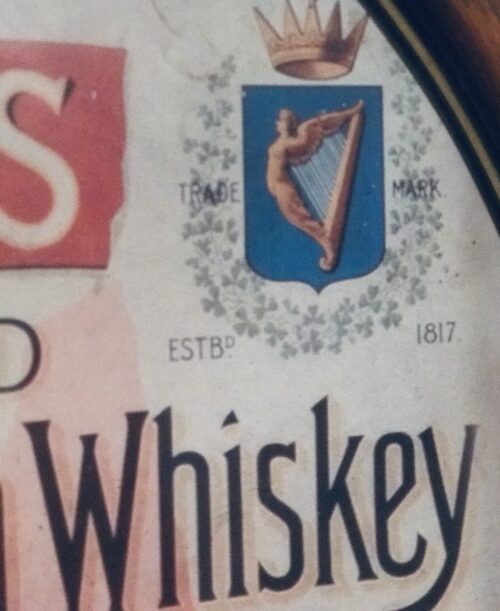
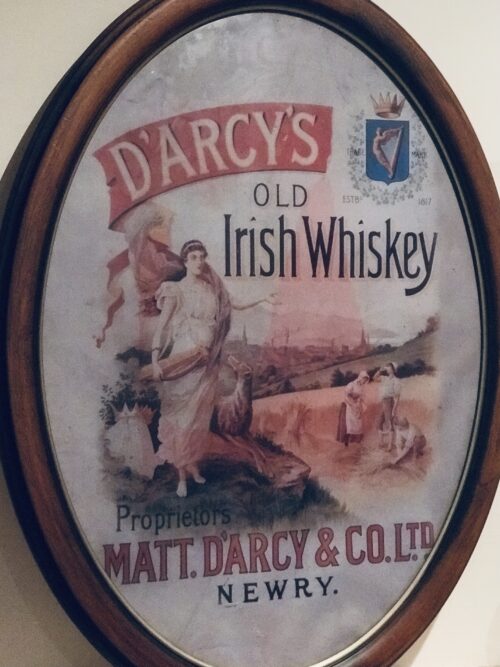 Newry Co Down 80cm x 57cm D'arcys of Newry Co Down were yet another example of a once thriving Irish whiskey distillery now sadly gone to the wayside despite the massive recent resurgence of the product.During one point in the late 1800s and early 1900s it seemed every town and village in Ireland had its own distillery as well as the obvious major commercial centres of Dublin,Belfast,Cork and Limerick.However that trend is now being reversed with the news this year that plans are afoot to reopen the old distillery in Newry and kick-start the rebirth of Matthew D'Arcy & Co .This charming print depicting a peaceful pastoral scene was used extensively by D'Arcys before its closure in the early part of the 20th century.
Newry Co Down 80cm x 57cm D'arcys of Newry Co Down were yet another example of a once thriving Irish whiskey distillery now sadly gone to the wayside despite the massive recent resurgence of the product.During one point in the late 1800s and early 1900s it seemed every town and village in Ireland had its own distillery as well as the obvious major commercial centres of Dublin,Belfast,Cork and Limerick.However that trend is now being reversed with the news this year that plans are afoot to reopen the old distillery in Newry and kick-start the rebirth of Matthew D'Arcy & Co .This charming print depicting a peaceful pastoral scene was used extensively by D'Arcys before its closure in the early part of the 20th century.




